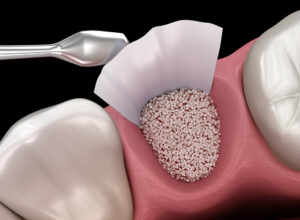The Problems with Extractions
When people lose teeth, they often experience shrinking of the remaining bone. Since chewing and biting stimulate bone growth in the jaw bone; a missing tooth will reduce this stimulus and signal the body’s osteoclasts to break down the jawbone. Although new bone continues to form, it occurs at a lower rate than the destruction of bone.
This is why tooth extraction is commonly linked to jawbone loss, according to research in the Indian Journal of Dentistry. In fact, up to a quarter of jaw bone loss can occur within only the first year after an extraction. Wearing dentures can increase the rate of bone deterioration. If the bone shrinks enough, a patient’s dentures may become too loose to wear.
As the bone continues to deteriorate throughout a person’s life, he or she may begin to experience impaired speech and chewing, along with muscle dysfunction. Unfortunately, the bone loss can also leave the person without sufficient soft-tissue or bone to support a prosthetic.
How Bone Grafts Help
Many dental professionals now use various bone-grafting materials to prevent these types of problems. One type of graft includes the use of organic materials composed of living tissues that promote bone formation. Dentists also use nonbiological “scaffoldings” designed to encourage bone growth.
Grafts provide a sort of matrix for new bone growth in defective areas, while also filling in extraction sites to maintain the width and height of the alveolar ridge. They are also performed to improve the success rate of dental implants, often in connection with the post-extraction implant. Bone grafts can be done alone or combined with various types of guided-tissue regeneration (GTR).
In addition to preventing or mitigating bone loss associated with tooth extraction, bone grafts can greatly enhance the aesthetics and function of implants, crowns and dentures. Bone-replacement grafts in the anterior region can also preserve ridge topography for the appearance and health of fixed bridgework.
At Healthy Smiles we offer Bone Grafting at the time of dental extractions and this will be discussed with the patient on a case-by-case basis. The technique is very helpful when there is an intention to fill the gap with a Dental Implant

